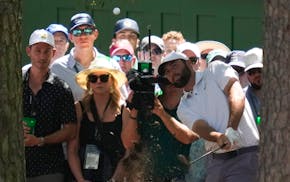The 2001 Twins followed eight consecutive losing seasons in one of baseball's worst ballparks with an 85-victory season in which they did not make the playoffs. They became one of the most beloved teams in franchise history.
The 2017 Twins are following six mostly poor seasons in one of baseball's best ballparks with a season that could produce 80-some victories and, perhaps, a playoff berth. Their 11-5 loss to Baltimore on Sunday completed a seven-game homestand in which they drew 30,000 fans just once.
Which is strange, if you compare the teams.
Both filled the roster with talented young position players. Both sent three players to the All-Star Game.
Both relied on an ace — Brad Radke then, Ervin Santana now — who relied more on savvy than stuff. Both featured an Everyman closer — Eddie Guardado took over the job in the second half of the '01 season; Brandon Kintzler has become an All-Star in this one.
Both made dramatic improvements in the field over their predecessors. Torii Hunter in 2001 emerged as a brilliant center fielder but he has nothing on this year's Byron Buxton with the glove.
In fact, the 2017 Twins may be more impressive in a few ways. Miguel Sano is a more impactful player and hits the ball farther than anyone on the 2001 squad. Santana has a better ERA than any of the 2001 starters. Target Field is far superior to the Dome.
So why was the 2001 team so much more popular?
There are a number of factors at work here.
In the late '90s, the Twins were not hated for their ineptitude. They were ignored. They were a low-revenue team playing in a lousy park. When they were bad, Minnesotans spent summer nights outdoors. Fans were not invested emotionally or financially in the Dome.
The Twins' collapse this decade followed 10 years of competitiveness and the construction of a publicly funded ballpark. Fans expected the latter to ensure continuation of the former. They felt they were owed victories, as taxpayers.
The 2001 team was such an upstart that nobody on the roster was making much money. They weren't just young; they were inexpensive. You could imagine them bunking together.
The 2017 team features Joe Mauer, who is making $23 million to be a below-average first baseman, and pitchers Phil Hughes and Glen Perkins, who will make almost $20 million combined this year to do little.
Marketing rarely works in sports, where the scoreboard and standings tell all, but in 2001 the Twins launched their "Get To Know 'Em" campaign. It worked because the Twins won early and because fans wanted to know more about an anonymous group.
That campaign wouldn't work for the 2017 Twins. We have been writing about Sano and Buxton for years. Santana is in his third year here. Essentially the same group of players contributed to the Twins' single-season resurgence in 2015.
There is a language barrier to consider. The 2001 Twins were a debate team with bats. Hunter, Doug Mientkiewicz, Guardado, LaTroy Hawkins, Jacque Jones and A.J. Pierzynski spoke eloquently about reviving the franchise.
The 2017 Twins' best player is Sano, who is likeable but speaks English as a second language. This is not a criticism. He speaks far better English than I speak Spanish. But this is not a team that writes its own stories.
The 2001 Twins went 47-34 at home. The 2017 Twins are 20-28 at home, and there have been plenty of good seats available all season.
There is a difference in media access. I used to spend hours in the Twins clubhouse before and after games, and the team's best players were generous with their time. Now there is less access and a larger media contingent, making the clubhouse atmosphere more corporate than personal when reporters are present.
This year's Twins might improve by 25 or more games over their 2016 performance. But it won't feel the same as 2001. We already know 'em.
Jim Souhan's podcast can be heard at MalePatternPodcasts.com. On Twitter: @SouhanStrib. • jsouhan@startribune.com

Souhan: Why Tiger Woods should keep swinging
Souhan: Scheffler wins Masters again, shows what makes him special
Morikawa falters in final round at Masters

Keeping up with the Joneses who helped design Augusta National's classic back nine


